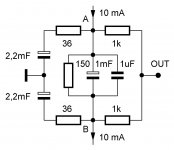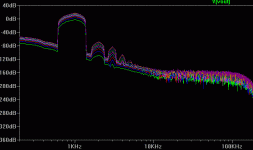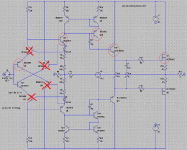Hi Sonnya,
I played with your schematic and found while running Monte Carlo that a practical imbalance in the mirror currents can cause quite severe cross-over distortion. When I say practical, I mean real life components.
Hi Nico
I think the effect of increasing current through TSSA mid-bridge load would result in the same bypassing way like all CCS-s Sonny choose. Collector load resistor (Rgs) can also be 10 k or any other prefered value (defined by mid-bridge load value) in this much more simple solution, which only aim is to prevent mid-bridge DC potential (bias current) from being unstable. Also because the mid-bridge resistance is positioned symmetrical to GND, no imbalance (DC offset) can be expected out of this variant, hopefully.
Attachments
To answer some more questions :
Do i think that the Sauermann is a good amplifier ?
Yes, i do and i also think it is a good value. He uses good parts and it is well build.
Do i think that my version of the Simple Symmetric is better ?
No, it is different but the differences are small, in the direction of taste. You could also say that the bass from the Sauermann is better controlled and tighter. I just was so mesmerized about the "massaging" effect that the Simple Symmetric had.
Never heard that before in such clarity.
You also have to consider that this assessment is only valid under the special circumstances. A speaker-room combination that is a bit overblown in the bass would certainly benefit from the Sauermann.
We where 3 experienced and professional listeners though and we heard very closely the same. That is quite rare so there is a good chance that it was real what we heard.
What is fascinating here is how the simplicity of TSSA amplifier topology can even be compared to such high sound quality players on the market as Sauerman is.And the more detail and speed we heard from the Simple Symmetric ?
It may simply be that the Simple Symmetric has less damping factor so a peak in the impedance curve between tweeter and woofer may cause that effect by bringing out the presence range just a little. That also would explain the deeper soundstage of the Sauermann.
I do not have an impedance curve of the updated LQL200 so this is an estimation.
Maybe i can get the actual curve from the designer.
I think the amp-cable-speaker-room interface has to be considered as system or we are in muddy waters.
This reminds me of the famous quote: 'I apologise for the length of this letter, I did not have time to write a short one'.
Elegant simplicity consumes huge energy and time. I've found this again and again. And it's always misjudged. Imagine how much time JLH spent honing his 10 watt 1969 amp!
Hugh
Elegant simplicity consumes huge energy and time. I've found this again and again. And it's always misjudged. Imagine how much time JLH spent honing his 10 watt 1969 amp!
Hugh
Hi Jay. This amp did already sound very good without a bufferstage before the mosfet. With the buffer the distortion is very very low even with a low idle current.
Hi, thanks Sonnya. I have simmed your circuit with 2N5401 and BD139 for the drivers. 1.5% THD at 20kHz. I think it's good for a hexfet (should be lower with laterals). And it is fast too. But too many stages, even tho the topology is a plus. And I can see what was mentioned by Nico. I don't know if it has audible effects but believe it or not top amps just don't have "issues". Later I will build this and compare it with my version of Mooly's M1 Hexfet.
I just was so mesmerized about the "massaging" effect that the Simple Symmetric had.
Never heard that before in such clarity.
Yes the SS frontend (and FB) I think gives the unique character. I don't know which part of the simulation data is responsible for that. The phase data is I think unique. Almost no issues with 4th order and higher. The spectrum is consistent with power. I like this amp except the 20kHz distortion, and the relatively high noise floor that has effect with bass quality (but can be minimized by careful choice of bypass capacitors and power supply). I have seen tho in my simulation, that this can be cured with integrated J/FET front end.
I haven't seen people simulating amp with a preamp. In real life there is this "matching" issues. A good amp might sound bad when paired with non-matching preamp. That's why I tried to simulate amps with at least simple volume control and buffer.
Attachments
Jay, with my cap multiplier PSU the noise is more or less non existent.
May be I'm using a wrong terminology when I say "noise floor". May be I'm doing it the wrong way, but I cannot see the effect of power supply on what I think is the noise floor in the chart I posted. My Mimesis clone for example, has the "base" for the FFT chart at -240dB. I have seen correlation between this and bass quality.
So from the chart I posted, whatever power supply that I used, the bottom of the 1kHz signal for example won't go down to -180dB.
Yes, I have used cap multiplier also.
Hi, thanks Sonnya. I have simmed your circuit with 2N5401 and BD139 for the drivers. 1.5% THD at 20kHz. I think it's good for a hexfet (should be lower with laterals). And it is fast too. But too many stages, even tho the topology is a plus. And I can see what was mentioned by Nico. I don't know if it has audible effects but believe it or not top amps just don't have "issues". Later I will build this and compare it with my version of Mooly's M1 Hexfet.
.
1.5% ????
But you dont use the same parts as i have done.
too many stages also??? - It is one stage more than the TSSA. Even fewer parts than the TSSA.
Last edited:
1.5% ????that is far higher then what i have build and measured......
But you dont use the same parts as i have done.
too many stages also??? - It is one stage more than the TSSA. Even fewer parts than the TSSA.
I was confused also reading that thread. Kenpeter modified your circuit and showed the FFT chart. To me the result is reasonable knowing the topology. But you mentioned on that thread that your circuit has better result and you showed an FFT where the noise floor is at -240db! I thought that was magnificent but seemed to good to be true. That kind of performance imo is possible only if the output lacks drive.
But my quick simm was different with yours. And you are talking about fewer parts than TSSA?
Attachments
-180dB ?
That is more then good enough.
Who is looking for good enough amp
You have stated that the Sauermann has tighter/better bass. I believe this can be seen from the simulated noise floor. In general, simple class-A amps have this similar problem. And I think F5 should be used as a reference in this league.
And you have stated also that these amps probably not good enough for rock (fast and complex music). That's the challenge. Good enough is not good.
I was confused also reading that thread. Kenpeter modified your circuit and showed the FFT chart. To me the result is reasonable knowing the topology. But you mentioned on that thread that your circuit has better result and you showed an FFT where the noise floor is at -240db! I thought that was magnificent but seemed to good to be true. That kind of performance imo is possible only if the output lacks drive.
But my quick simm was different with yours. And you are talking about fewer parts than TSSA?I was talking about your amp in the pdf above. It is no simpler than TSSA. I don't have pdf reader here so I attached Kenpeter's version:
Jay, I think we should take this discussion in the thread where it belongs Jay.
But as you see i use KSA1381 amd KSC3503 instead of BD139 and BD140. First of all the those transistor are several time better than BD139 and BD140.
The circuit you posted is more complicated than the one i have made. That is certainly not my design. The front-end not a good one either in the circuit you have posted.
Secondly i have measured on the previous one without the bufferstage.. They are also public....
Before comment on this circuit, please do it on the original circuit and not a modified one!!!!!!!!!!!!!!!!!!!!!!!
Jay, I think we should take this discussion in the thread where it belongs Jay.
You are right, Sonnya. Tho there are common ideas that can be implemented both in TSSA and in your amp. The input stage for example, can borrow from TSSA. I will try that to my TSSA (using your output stage).
And yes, that VAS transistors you use are among the best. In TSSA I found that chosen transistors for the input matter a lot. I haven't seen how the KSA perform in the TSSA.
You are right, Sonnya. Tho there are common ideas that can be implemented both in TSSA and in your amp. The input stage for example, can borrow from TSSA. I will try that to my TSSA (using your output stage).
And yes, that VAS transistors you use are among the best. In TSSA I found that chosen transistors for the input matter a lot. I haven't seen how the KSA perform in the TSSA.
Hi Jay
When parts count is small than each part's role is of more importance and therefore each and everyone of them has to be as best as possible.

Please try to stick to the main TSSA sch and derivates produced by Sonny and me if you like to reproduce similar results. Otherwise you're free to do whatever you like to bring you more pleasure.
Regards Andrej
Hi Jay
When parts count is small than each part's role is of more importance and therefore each and everyone of them has to be as best as possible.
Agree. But I cannot find those KSC parts locally, so I will stick with BC547C/557C (note: C class for highest hfe), MPSA42/92 and 2N5401/5551. The hfe is selected from many transistors (a thousand for 2N5401) to get above 300 of hfe (using DMM).
Oh, and I have a very good old toshiba transistor, but cannot find the model, so that will be tried during listening session by "plug and compare".
Please try to stick to the main TSSA sch and derivates produced by Sonny and me if you like to reproduce similar results. Otherwise you're free to do whatever you like to bring you more pleasure.
I have built the basics for lateral T/SSA and awaiting for the FINAL version
For HEXFET TSSA, nobody work on it so there I do my experiments. Because hexfets are cheap
- Home
- Amplifiers
- Solid State
- TSSA - The Simplest Symmetrical Amplifier




